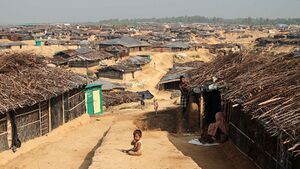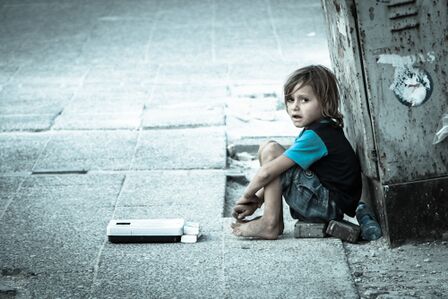Child Health Conditions and Migration
Original Editor - Graziella Lippolis & Pasala Maneewong from Humanity and Inclusion as part of the PREP Content Development Project
Top Contributors - Naomi O'Reilly, Ewa Jaraczewska, Kim Jackson, Wanda van Niekerk, Lucinda hampton, Jess Bell, Rucha Gadgil, Chelsea Mclene and Kirenga Bamurange Liliane
Introduction[edit | edit source]
Displaced persons face many challenges. Among these people, children are particularly at-risk and have to be considered as a specific vulnerable target group. Here are some examples of health situations that particularly affect children who have been displaced.
Early Detection and Early Management of Impairment [edit | edit source]
Many displaced pregnant women go through pregnancy and childbirth without access to adequate health facilities, resulting in more high-risk pregnancies and childbirths. This lack of health care, may also result in a higher incidence of birth complications. It can also be inferred that impairments that could be diagnosed at birth are often missed, or its confirmation is delayed. Moreover, when impairments are recognised, the following problems may occur:
- limited access to suitable health services for the child
- lack of structures for the management of child's health services
- lack of specialised services
In camps for displaced persons, health agencies are mostly only able to provide basic primary health care services. Therefore, children with cleft lip, spina bifida, hydrocephalus, cerebral palsy, clubfeet, and other disabilities have fewer opportunities to access specialist services.
A lack of access to early rehabilitation services can reduce the developmental potential of affected children. For example, many children born with clubfoot may not have access to care for several months. Therefore, they will more likely have permanent deformities or require surgery. Similarly, children born with or having acquired cerebral palsy may not be diagnosed with this condition until they are 2 years old and still cannot walk. This delay in diagnosis drastically reduces the child's potential for development.
Access to Vaccination[edit | edit source]
Children who are born on the migration route or in a country where they do not have legal status may not have access tovaccination programmes. Vaccination is often available within long-term camps for displaced persons. However, many children are born or grow up outside these camps. Thus, they do not have access to basic vaccines even though they are in precarious health situations. Polio, rubella and measles are infectious diseases directly related to poor living conditions. Some factors that increase the risk of proliferation of infectious diseases are: overcrowding, rudimentary shelter, and a lack of drinking water or soap. For example, in 2004, 66% of displaced Liberians in camps for displaced persons in the Ivory Coast were tested for measles. The highest incidence rate was seen in children under 9 months of age.[1]
Malnutrition[edit | edit source]
It is estimated that more than 200 million children under the age of 5 years (43% of all children younger than five years of age[2]) are unable to reach their full developmental potential because of poverty, poor health, poor nutrition and inadequate care.[3] There are many causes of child malnutrition, including migration and/or displacement. Examples of displacement include:
- displacement as a result of conflict, such as in Syria
- displacement due to political problems, such as in Cox Bazaar in Bangladesh
- situations of deprivation due to humanitarian crises and climate change which pushes families to move to more livable areas.
Forced migration can directly affect nutrition and the growth and development of children. There is limited access to quality food during periods of displacement. In displaced persons camps, there may be limited rations and limited variety of foods. In tases camps, children are often not prioritised for adequate food access. In addition, parents often sell part of their food rations without ensuring adequate nutrition for their children for economic reasons. It is also important to remember that some supplementary foods provided by agencies may be new or different from what parents / carers have previously eaten.
It is very important to assess the type of food provided, both culturally and nutritionally, and to educate parents on how to prepare these foods or supplements for their children. Otherwise, there is the risk that these foods will be spoiled or not used effectively to feed children.
- Children aged under 5 years who experience severe acute malnutrition often present with developmental delay. Recent data suggests a strong interaction between malnutrition, neuromuscular diseases and cognitive deficit, leading to a significant burden on a global scale.[4]
- In camps for displaced persons, rehabilitation professionals often work with children with varying degrees of malnutrition and subsequent developmental delays. Thus, a combination of physiotherapy and nutritional rehabilitation may be beneficial.
Developmental Delays[edit | edit source]
Acute malnutrition is not the only cause of developmental delay. Other factors that reduce a child's opportunity for motor, cognitive and social development include:
- lack of opportunities for stimulation
- living in confined spaces
- limited, or lack of access to any games or stimulation materials
- need to fend for themselves at a very early age
- care provided by slightly older siblings
Response[edit | edit source]
In order to compensate for these increased risks, the following are advisable:
- Early detection services should be offered for newborns/children in camps for displaced persons to accompany services for pregnant women.
- Referrals to specialised care services and follow-up for children identified as having an impairment or being at risk of developing one through collaboration among health agencies in camps, as well as the host states. This will help ensure the consistent and effective flow of referrals for children with impairments.
- Supporting the child's needs through seeking out particular projects or services surrounding the camps or not far away. Services could include: mobile support, centre-based support or distance support depending on what is available in each context.
- Training available medical staff in providing basic management of an impairment. They may be able to provide basic rehabilitation to support children to minimise secondary complications.
- Ensuring that children have received essential vaccines. Some host counties or main states might have policies to cover the vaccines for children in camps for displaced persons. It is, therefore, important to assess the policy of their services to support the children in camps.
- Monitoring the nutritional situation of children and offer food supplements in cases where there is malnutrition.
- Early intervention and early stimulation services for refugee populations should be available, including specific play areas.
Some families may not regularly play with or offer stimulation to their children. Thus, it is advisable to propose workshops for parents to show the benefits of play and stimulation, and to teach them how to promote play as part of their daily life activities.
In addition, these responses must be reassessed, monitored, and followed up, to ensure that the response is continuously and regularly redesigned. Because major displaced persons camps are dynamic environments, systems and agreements can collapse or be halted. The key factors behind this negative dynamic which might result in lose of support or follow up for the child are as follow:
- decisions made by authorities or camp committee staff
- agency staff rotations,
- refugees' families movement between shelters
Child Stimulation and Malnutrition[edit | edit source]
In some refugee camps, rehabilitation specialists have developed Early Childhood Stimulation Therapy (ECST). This is implemented in conjunction with emergency nutrition, rehydration and essential medical care in order to give children the best chance of survival, increased resilience, and improved future quality of life.[5]
Individual Early Childhood Stimulation Therapy sessions for acute malnourished children can:
- Prevent impairments and deficits
- Reduce developmental delay
- Improve motor, sensory, language and cognitive skills
- Restore the parent-child bond
- Help the mother, father or caregiver to stimulate the child and have fun with him/her.
- Educate the parents about warning signs related to the specific condition of their child and when they should seek to consult specialised services
The mother, father or caregiver attends these sessions to learn how to stimulate the child at home and find enjoyment in playing with the child. Through play, the child and carer give themselves the means to flourish in their complex and changing environment. A study in Mali[6] indicated that the overall development score and score for motor skills are significantly higher in children who have undergone motor therapy stimulation.
Resources[edit | edit source]
- UNICEF Migration and Children
- UNICEF examines migration and the impact it has on children and highlights key directions for future research to understand how children are affected by migration and to advocate for policies to mitigate its adverse impact on their well-being
- International Society for Social Paediatrics and Child Health (ISSOP) Position Statement on Migrant Child Health
- The objectives of the ISSOP Position Statement on Migrant Child Health are to:
- "Raise awareness of the magnitude of specific health and social problems affecting migrant children and the inherent right of every child to be helped and protected."[8]
- "Advocate for the right of every child to be provided equal access to the best health and social care available regardless of their legal status."[8]
- "Call for action for societies to honour their duty to help every migrant child to achieve their potential to live a happy and healthy life, by preventing disease, providing appropriate medical treatment and supporting social rehabilitation."[8]
- The objectives of the ISSOP Position Statement on Migrant Child Health are to:
- Health of Refugee and Migrant Children - Technical Guidance
- "The objective of this technical guidance is to inform national and local health policy regarding health care for newly arrived refugee and migrant children. This grouping encompasses children aged 0–18 years who are asylum seekers, in an irregular situation or in the first two years after obtaining residency in the country of reception. The guidance, therefore, focuses on the initial health care response to the needs of these children."[9]
References[edit | edit source]
- ↑ United Nations University. Eradicating Measles Outbreaks in Refugee Camps. Available from:https://unu.edu/publications/articles/eradicating-measles-outbreaks-in-refugee-camps.html (Accessed 28 July 2020).
- ↑ Kumar P, Rohatgi S, Singh P, Daniel A. Strengthening Psychosocial Stimulation in the Management of Children With Severe Acute Malnutrition: Experience From a Nutrition Rehabilitation Center. Indian Pediatr. 2021 Nov 15;58 Suppl 1:S42-S45.
- ↑ Engle PL, Black MM, Behrman JR, De Mello MC, Gertler PJ, Kapiriri L, Martorell R, Young ME, International Child Development Steering Group. Strategies to avoid the loss of developmental potential in more than 200 million children in the developing world. The lancet. 2007 Jan 20;369(9557):229-42.
- ↑ Grantham-McGregor S, Cheung YB, Cueto S, Glewwe P, Richter L, Strupp B, International Child Development Steering Group. Developmental potential in the first 5 years for children in developing countries. The lancet. 2007 Jan 6;369(9555):60-70.
- ↑ Bekele A, Janakiraman B. Physical therapy guideline for children with malnutrition in low income countries: clinical commentary. Journal of Exercise Rehabilitation. 2016 Aug;12(4):266.
- ↑ Camara MD, Diop CT, Bassoum O, Tine JAD, Mahmoud MI, Leye MMM, Ndiongue M,Niang K, Faye A. Study of the Efficacy of Stimulation Physiotherapy in the Management of Severe Acute Malnutrition in Children Aged 6-59 Months in Bamako, Mali, American Journal of Pediatrics, 2020; 6(1):12-21.
- ↑ Handicap International. BurkinaSantéFR Available from: http://www.youtube.com/watch?v=pVv5ccpgVsA[last accessed 28/07/2020]
- ↑ 8.0 8.1 8.2 ISSOP Migration Working Group on behalf of ISSOP. ISSOP Position Statement on Migrant Child Health, 2017.
- ↑ Health of refugee and migrant children. Copenhagen: WHO Regional Office for Europe, 2018 (Technical guidance on refugee and migrant health).








